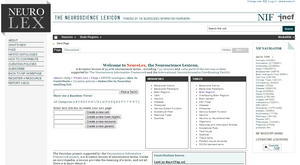NeuroLex
 |
|
|---|---|
| Content | |
| Description | Dynamic lexicon of neuroscience terms in a |
| Data types captured |
Neuroscience |
| Contact | |
| Authors | Maryann Martone, Stephen Larson and others |
| Access | |
| Website | |
| Miscellaneous | |
| License |
Creative Commons Attribution 3.0 Unported License |
NeuroLex is a dynamic lexicon of neuroscience concepts. It is a structured as a , using . NeuroLex is supported by the Neuroscience Information Framework project.
The NeuroLex is intended to help improve the way that neuroscientists communicate about their data, so that information systems like the NIF can find data more easily and provide more powerful means of integrating data that occur across distributed resources. One of the big roadblocks to data integration in neuroscience is the inconsistent use of terminology in databases and other resources like the literature. When one uses the same terms to mean different things, one cannot easily ask questions that span across multiple resources. For example, if three databases have information about what genes are expressed in cortex, but they all use different definitions of cerebral cortex, then one cannot compare them easily.
The NIF enables discovery and access to public research data and tools worldwide through an open source, networked environment. Funded by the NIH Blueprint for Neuroscience Research, the NIF enables scientists and students to discover global neuroscience web resources that cut across traditional boundaries – from experimental, clinical and translational neuroscience databases, to knowledge bases, atlases, and genetic/genomic resources.
Unlike general search engines, NIF provides deeper access to a more focused set of resources that are relevant to neuroscience, search strategies tailored to neuroscience, and access to content that is traditionally “hidden” from web search engines. The Framework is a dynamic inventory of neuroscience databases, annotated and integrated with a unified system of biomedical terminology (i.e. NeuroLex). NIF supports concept-based queries across multiple scales of biological structure and multiple levels of biological function, making it easier to search for and understand the results.
As part of the NIF, a search interface to many different sources of neuroscience information and data is provided. To make this search more effective, the NIF is constructing ontologies to help organize neuroscience concepts into category hierarchies, e.g. stating that a neuron is a cell. This allows users to perform more effective searches and also to organize and understand the information that is returned. But an important adjunct to this activity is to clearly define all of the terms that are used to describe data, e.g., anatomical terms, techniques, organism names.
...
Wikipedia
